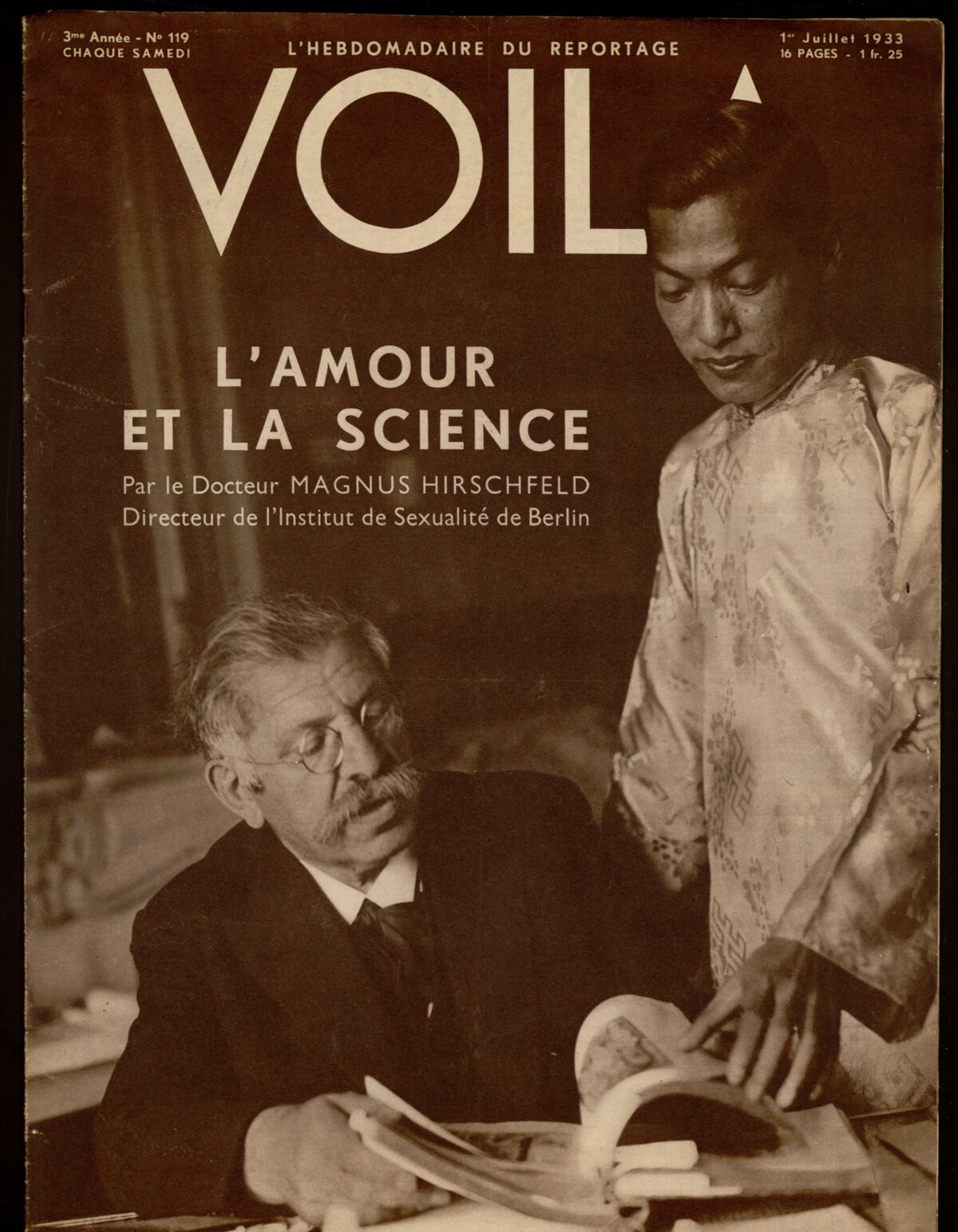
Agrandissement : Illustration 1

The article uses sources from 1910s-1930s French Press. Hirschfeld was known in France at this time, even when he died in Nice. Some views presented on this sources can be LGBTphobic in today's views.
Father of the LGBTQIA+ movement
Hirschfeld was born in 1868. In 1897, he created the Scientific-Humanitarian Committee, the first German association standing for "homosexuals".
Hirschfeld's first goal was to abolish the Paragaph 175, used to jail LGBT+ people. Bills were written to do so in 1898 and 1920s, but failed to pass.
During the 1900s-1910s, he realized scientific researches about "homosexuals", "inverted" (in French : "invertis"), "abnormal" people and "transvestites"*. Some of his actions were mentionned and even criticized by French medias. In 1907, he was an expert during the Eulenburg Affair.
Historian Nicolas Le Moigne says : « Magnus Hirschfeld [...] contributes both to the foundation of the gay emancipation movement and to the psychiatrization of "inversion" ».
A figure under Weimar
In 1919, he standed for a Democratic and socialist German Republic. The French newspaper L'Humanité published a call written by Hirschfeld, the journalist Kurt von Tepper-Laski and Philosophy Dr. Helene Stöcker.
The same year, he created the Institute for Sexology in Berlin. He participated at movies about LGBTQIA+ people, presenting the French Napoleonian Code as better than the German Code. In 1921, he created the World League for Sexual Reform, with several national branches around the World.
He his presented as the "Most hated man in Germany" because of his pioneer researches on trans healthcare, his advocacy for abortion etc. French journalists went to Berlin and / or wrote about him and the Institute. He helped French trans persons, talked about sex education for example. Helene Stöcker, who was a figure of German Feminist Movement (and advocated for homos rights), worked at the Institute.
Banned under the Third Reich
Nazis already targeted him during 1920s (harrassment campaigns, attempted attacks...). In 1920s, even a French media wrote he was dead after an antisemitic attack during one of his conferences, in Munich.
But, Hirschfeld discovered in 1933 inside a Parisian cinema what Propaganda Minister Joseph Goebbels wanted : destroy his work by fire.
During the campaign against 'Un-German' spirit, nazi students ransacked his Institute (May 6) and organized a book burning in Berlin (May 10). According to researchers, Hitler said that Hirschfeld was the "most dangerous Jew in Germany". He was among the "most dangerous" authors during the 10th of May book burning.
L'Amour et la Science / Love and Science
In April 1934, Hirschfeld created a new Institute in Paris : L'Institut de Psychobiologie, thanks to his former boyfriend, Karl Giese. And the League seated in Paris at this time.
However, Giese was arrested for "public indecency". Laws from Napoleonian Code existed against LGBT+ people in France.
Hirschfeld died in Nice during his 67th birthday (May 14, 1935). Doctors were present at the funeral. His heirs were Karl Giese and Li Shiu Tong, his actual boyfriend. French medias wrote articles about his life until WWII.
Per scientam ad justitiam ?
After the War, Harry Benjamin (who met Hirschfeld before), developed trans healthcare again, basing his work upon Hirschfeld's one.
Some Hirschfeld's theories still being used today. But some others are not. Eugenistic and racist ideas limited his views on sexology researches.
Members of LGBTQIA+ Communities and feminists rejected social darwinism and psychoanalysis. This pseudosciences were used by feminists, socialists and sexologists during Weimar Republic. Through the years in Germany regimes and others, it was used for criminalization or decriminalization. But also for pathologization. According to historians, Hirschfeld was a pioneer for LGBTQIA+ rights, but also sex, orientations and gender studies.
Notes.
*"Homosexuals", "abnormal" people, "invertis" and "transvestis" (in French, "homosexuels", "homosexuelles", "anormaux", "anormales", "invertis", "inverties" et "transvestis") were used for homos, drag queens & kings, and bi or trans people.
*"Scientific" eugenism and racism could be used by doctors at this time. Theories reviewed since. Hirschfeld wrote a book about racism and changed his views on it. But, it was published posthumously.
*Psychoanalysis is a pseudoscience. But sexology is a kind of "deinstitutionalized" science. Freud's and Hirschfeld's books were burned by Nazis because they were Jews. Psychoanalysis was a "Jew science" for them. Maybe they thought the same thing for sexology.
*Per Scientam ad justitiam, "Through science to justice" in Latin, was used by Hirschfeld. And it is written on his tomb in Nice.
References.
D'Artagnan, Bégous, Sidéris. "La fluidité de genre de l’Antiquité à nos jours. Des faits trans à
toutes les époques". Institut La Boétie.
Laurie Marhoefer. Racism and the Making of Gay Rights: A Sexologist, his Student, and the Empire of Queer Love. 2022. Toronto University Press.
Agathe Bernier-Monod. Les stratégies de communication de l’Institut de Magnus Hirschfeld (1919-1933). Sciences de l’Homme et Société. 2010
Le Moigne, Nicolas, 2005, « L’affaire Eulenburg : homosexualité, pouvoir monarchique et dénonciation publique dans l’Allemagne impériale (1906-1908) », Politix, no 71, p. 83-106.
Sources.
E. Vermeil (writer). Bulletin de la presse allemande. 14th of October 1920.
https://gallica.bnf.fr/ark:/12148/bpt6k3217333x/f1.item.r=Magnus%20Hirschfeld.zoom
Henri de Weindel et F-P. Fischer. L'homosexualité en Allemagne. La Lanterne. 14th of May 1908.
https://gallica.bnf.fr/ark:/12148/bpt6k7516940c/f2.item.r=Fran%C3%A7ois%20de%20Menthon%20homosexuels.zoom#
"L'Amour et la Science par le Docteur Magnus Hirschfeld, directeur de l'Institut de Sexologie de Berlin". Voilà n°119. Gallimard (1st of July 1933).
Crips Liliane. Magnus Hirschfeld (1868-1935), un eugéniste social-démocrate. In: L'Homme et la société, N. 87, 1988. La démocratie en défaut. pp. 104-114. https://doi.org/10.3406/homso.1988.3210
Romain Rolland. La Ligue "Nouvelle Patrie" et la Révolution Allemande. Journal L'Humanité. 27th of January 1919.
https://gallica.bnf.fr/ark:/12148/bpt6k2555376/f1.item.r=Magnus%20Hirschfeld.zoom
Edmond Zammert. Extrait d'Archives internationales de neurologie : revue trimestrielle des maladies nerveuses et mentales. 1st of March 1934.
https://gallica.bnf.fr/ark:/12148/bpt6k9584326r/f42.image.r=Magnus%20Hirschfeld?rk=450646;0
Louis Charles Royer. À l'Institut. Gringoire. 12th of September 1930.
https://gallica.bnf.fr/ark:/12148/bpt6k4746932h/f2.item.r=Magnus%20Hirschfeld.zoom
La Tribune Juive Paris-Strasbourg. Lettre niçoise / La mort de Magnus Hirschfeld. 31st of May 1935.
https://gallica.bnf.fr/ark:/12148/bpt6k63258335/f10.item.r=Magnus%20Hirschfeld.zoom
Pierre Scize. Aux assises des temps nouveaux. Voilà. N°83. Gallimard. 22nd of October 1932.
https://gallica.bnf.fr/ark:/12148/bd6t51125292f/f9.item.r=Magnus%20Hirschfeld.zoom



